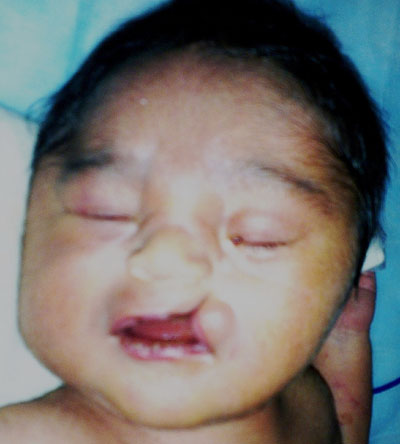Congenital choanal atresia (CCA) is the developmental failure of the
nasal cavity to communicate with nasopharynx. Bilateral CCA is an acute
emergency in an obligatory nasal breathing neonate. The bilateral
involvement in this anomaly presents immediately after birth as
respiratory distress and cyanosis, except while crying. We herein
describe a newborn with bilateral CCA presenting with no distress either
at birth or subsequently during rest, due to a co-existing anomaly.
A full-term male neonate was born by normal vaginal
delivery in an island hospital at Andamans, India. Mother had uneventful
antenatal and intrapartum course. At birth, he weighed 3100 grams and
cried well. Baby was noted to have an incomplete cleft lip along with
coloboma of the left eye lid flanked by a tissue tag. Neonate had a
broad and prominent nasal bridge. Baby was breathing normally with an
oxygen saturation of 100% in room air. Neonate was roomed-in with mother
after clinically ruling out other serious anomalies like cardiac
defects. After one hour of delivery, the baby was noted to have
developed restlessness, hypoxia and cyanosis on attempt to breast feed.A
possibility of upper airway obstruction, particularly bilateral CCA, was
entertained. An attempt to pass the catheter through both the nostrils
was unsuccessful, confirming the clinical suspicion. A large button of
tissue of lip adjacent to the narrow cleft on upper lip was keeping the
mouth open during rest resulting in good breathing through the
oropharynx with distress appearing only while feeding (Fig. 1).
As facilities to investigate further and manage were not available at
the remotely located island hospital, the baby and mother were
transferred by air to a tertiary care centre at Kolkata within 24 hours
of diagnosis. The imaging studies confirmed bilateral CCA with
membranous atresia on the left side and bony atresia on the right.
Cardiac echocardiogram was normal. There were no renal, ear, genital or
other ocular abnormalities. Obstruction due to membranous atresia was
relieved surgically within 24 hours and intervention for the bony
obstruction was scheduled for a later date. Baby made an uneventful
recovery and was thriving well during follow up review at 6 weeks of
life.
 |
|
Fig. 1 The anomalous button of tissue
adjacent to upper lip cleft, keeping the mouth wide.
|
This infant had persistent opening of the mouth due
to a large button of tissue adjacent to a narrow cleft at upper lip,
preventing approximation of lips and leaving the mouth sufficiently open
to breathe. This association masked the clinical manifestation at rest,
even with the mouth ‘closed’. Belegere, et al. [1] described a
case in which bilateral CCA associated with craniofacial anomalies did
not present with respiratory distress in the neonatal period as the baby
had a complete unilateral cleft lip which facilitated oropharyngeal
respiration. The case described in this report had a very narrow and
incomplete cleft; however, the anomalous large tissue of upper lip
prevented closure of mouth and ensured oral airway patency.

